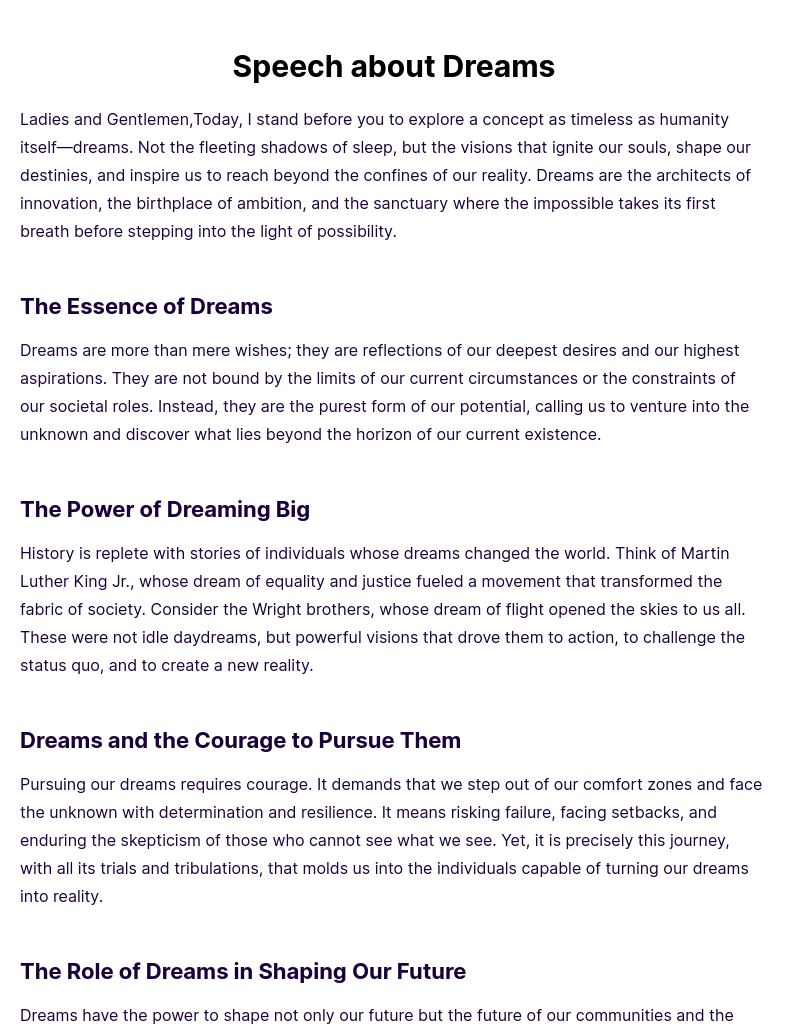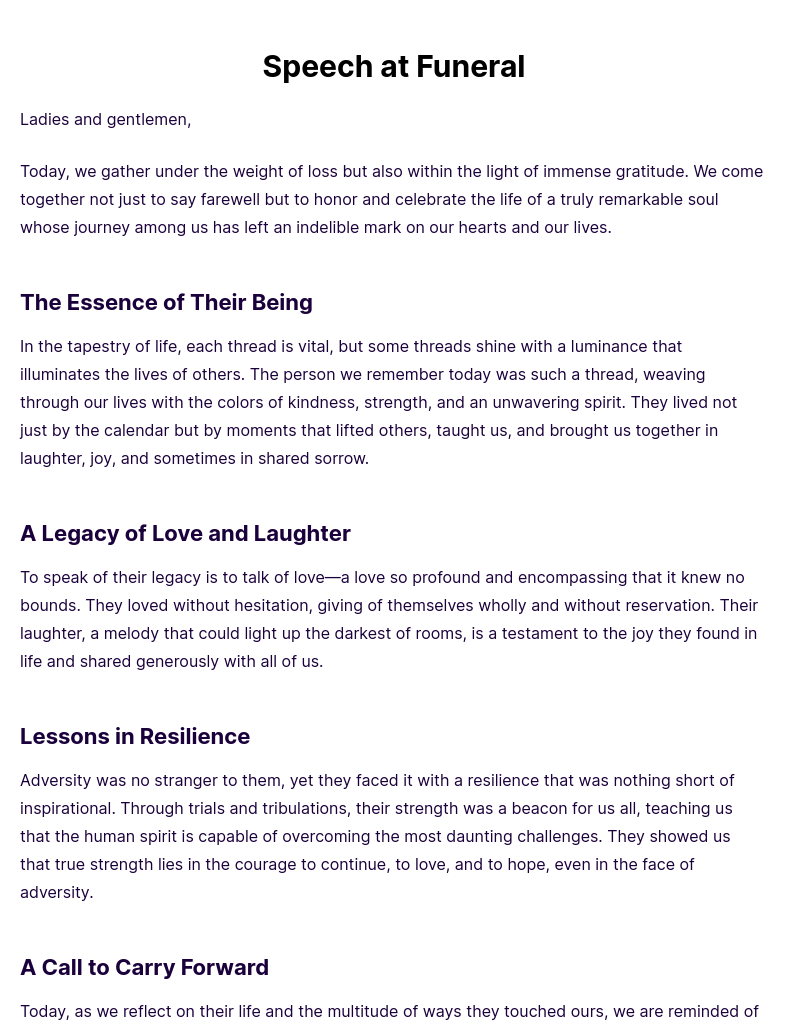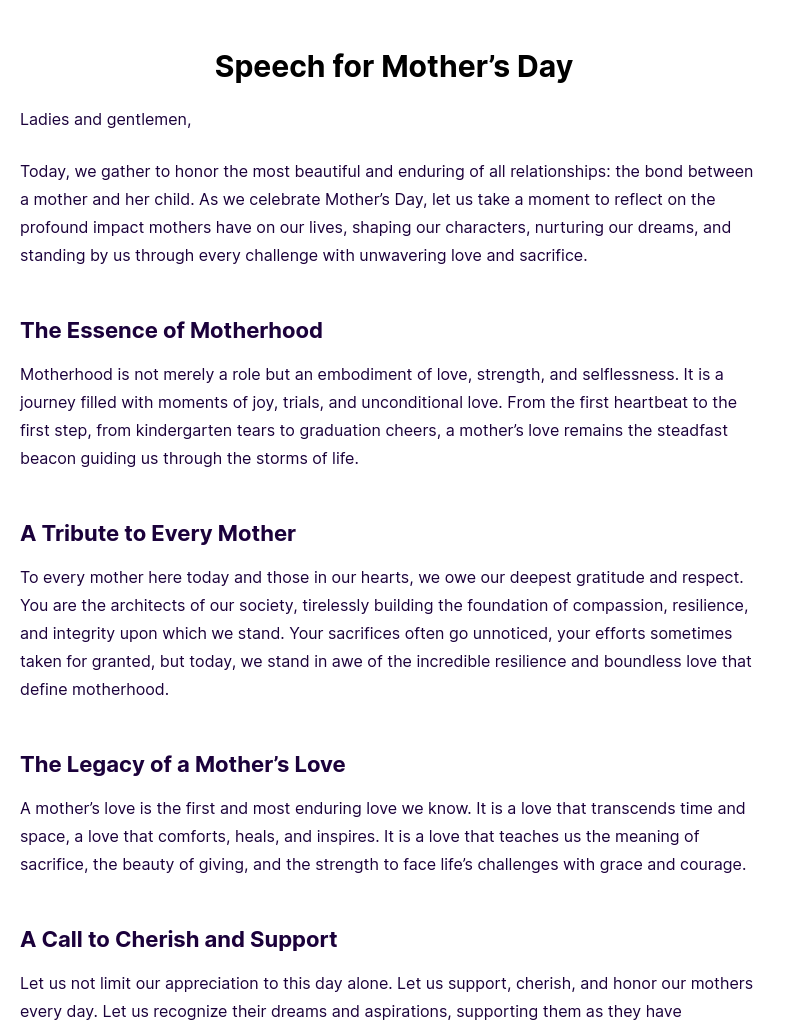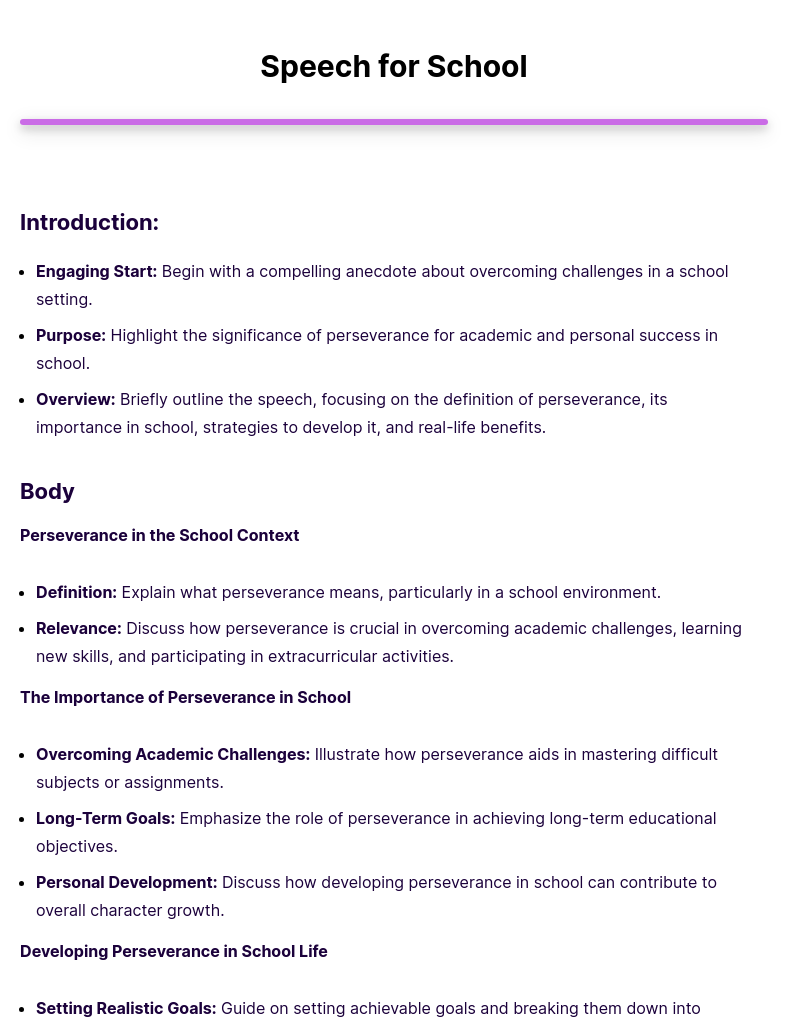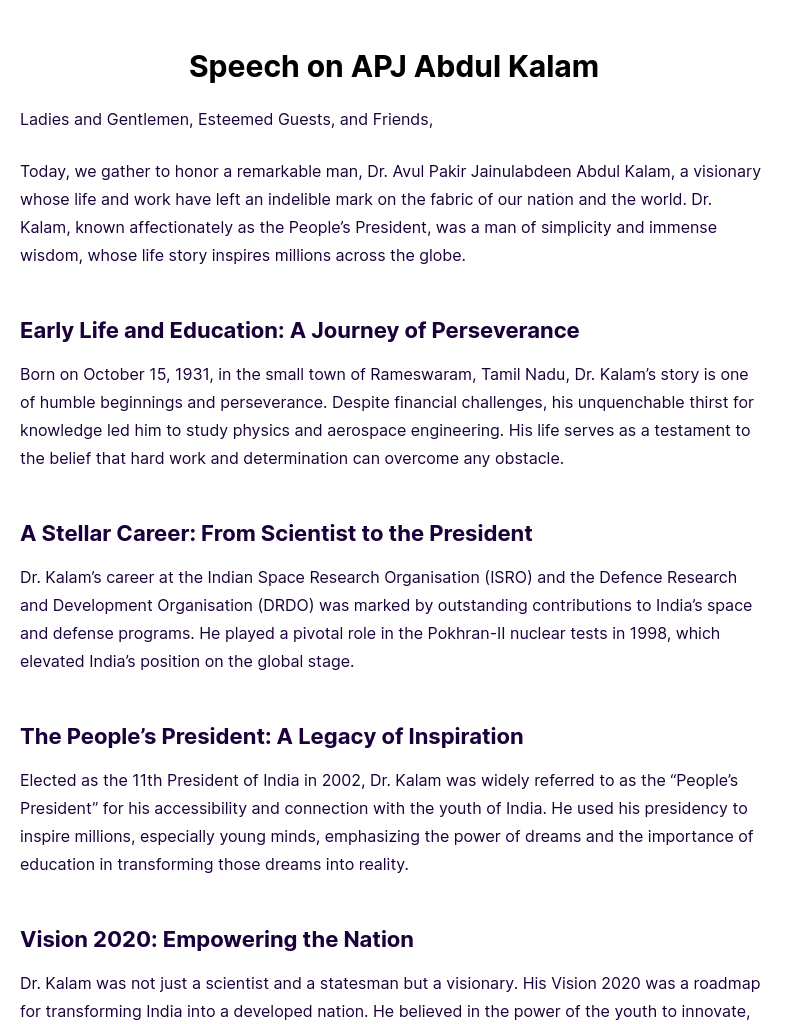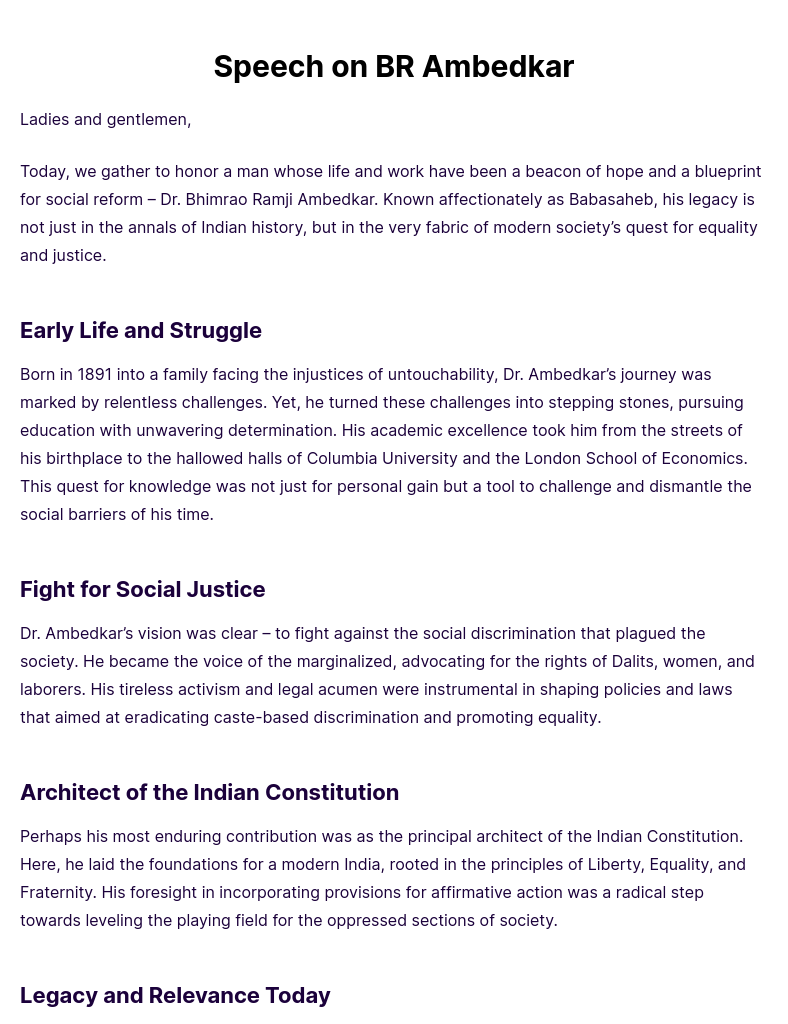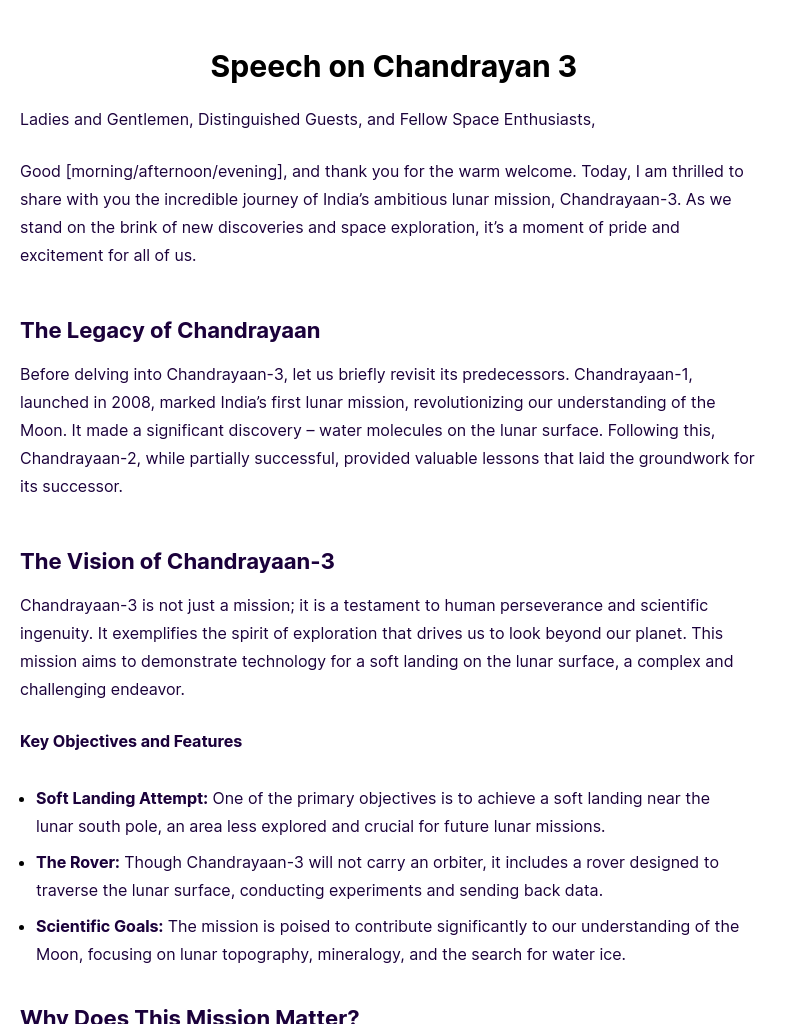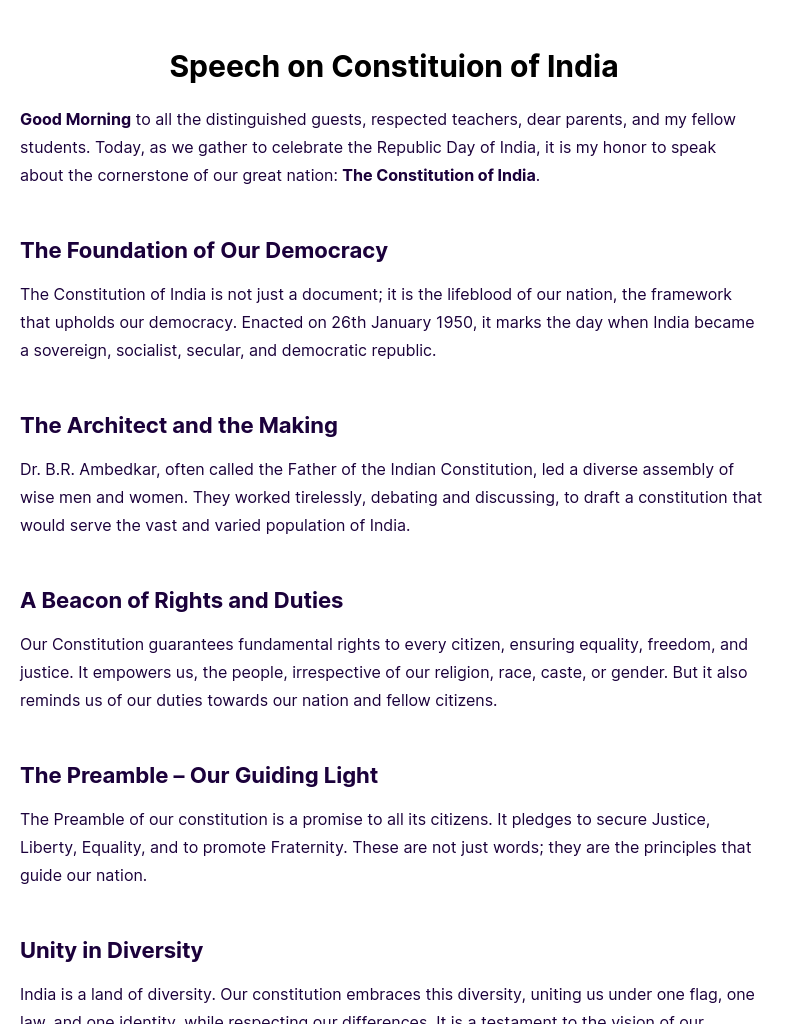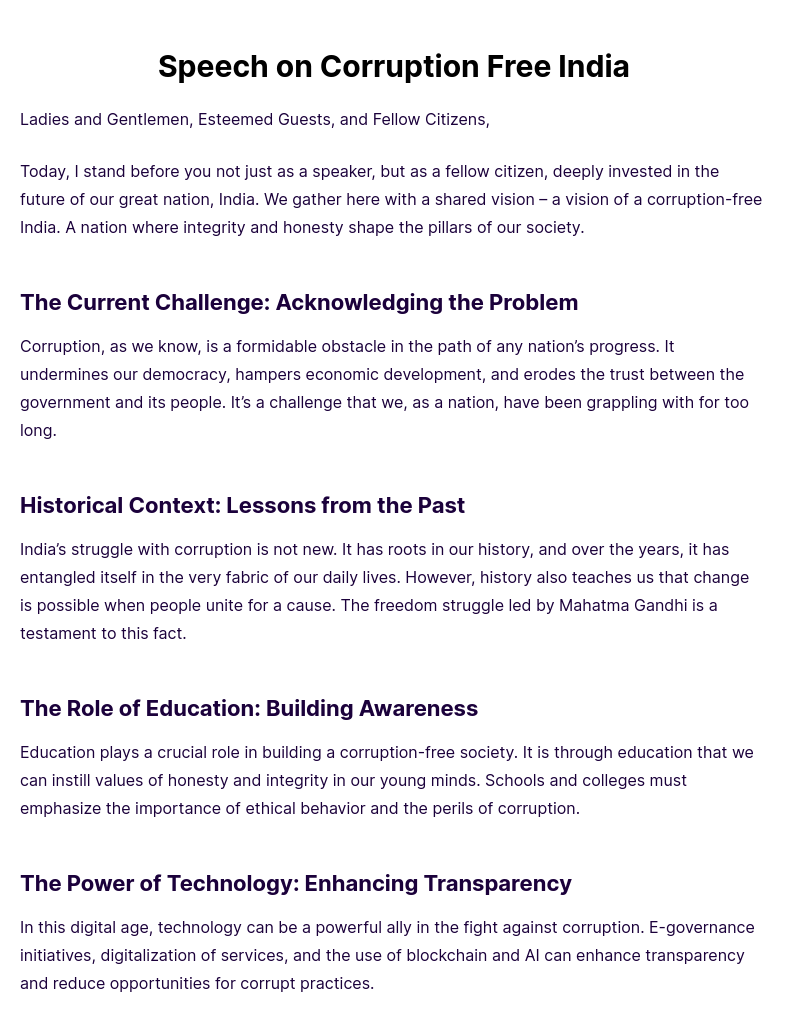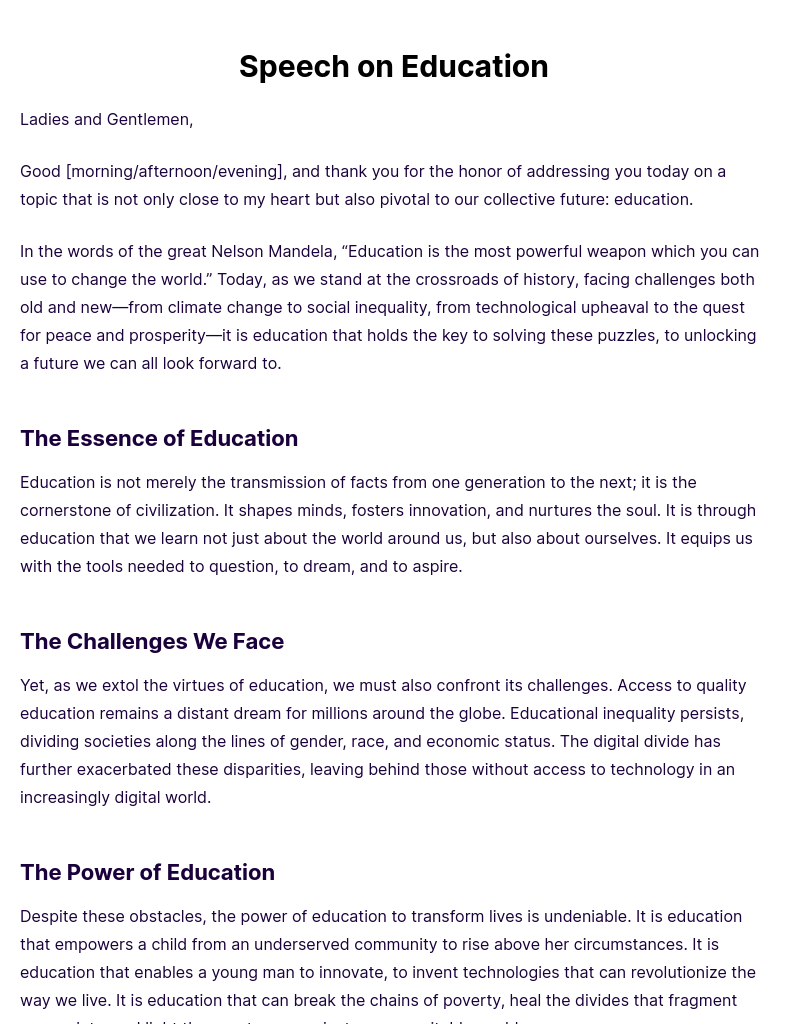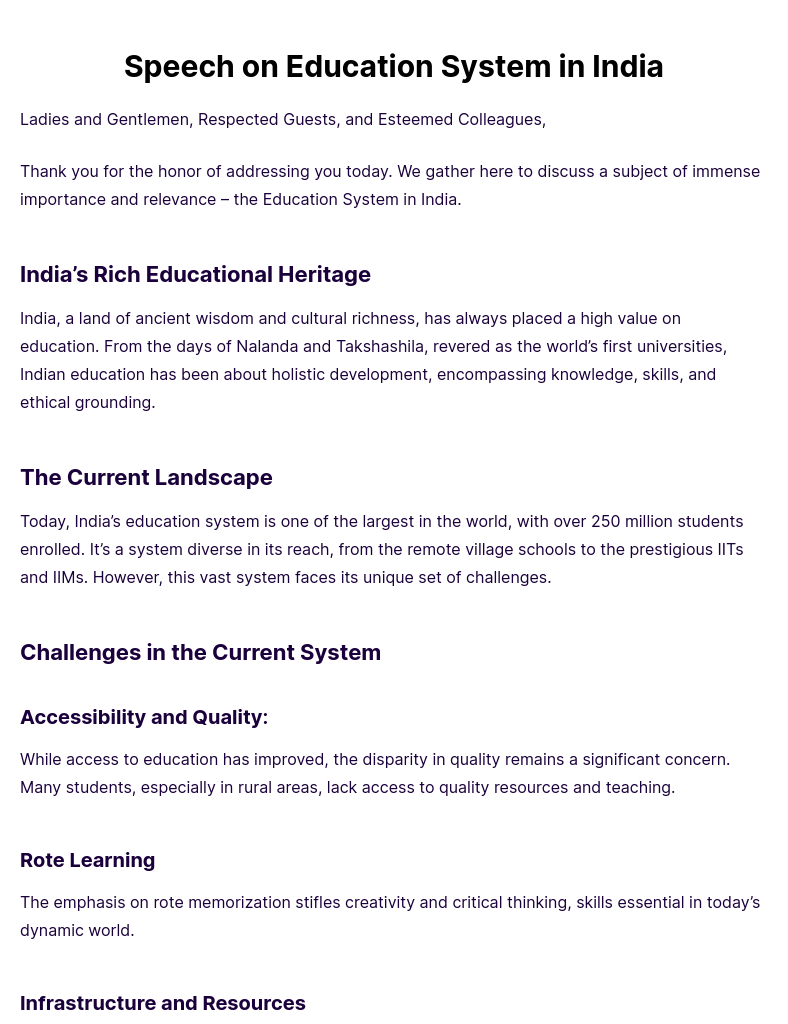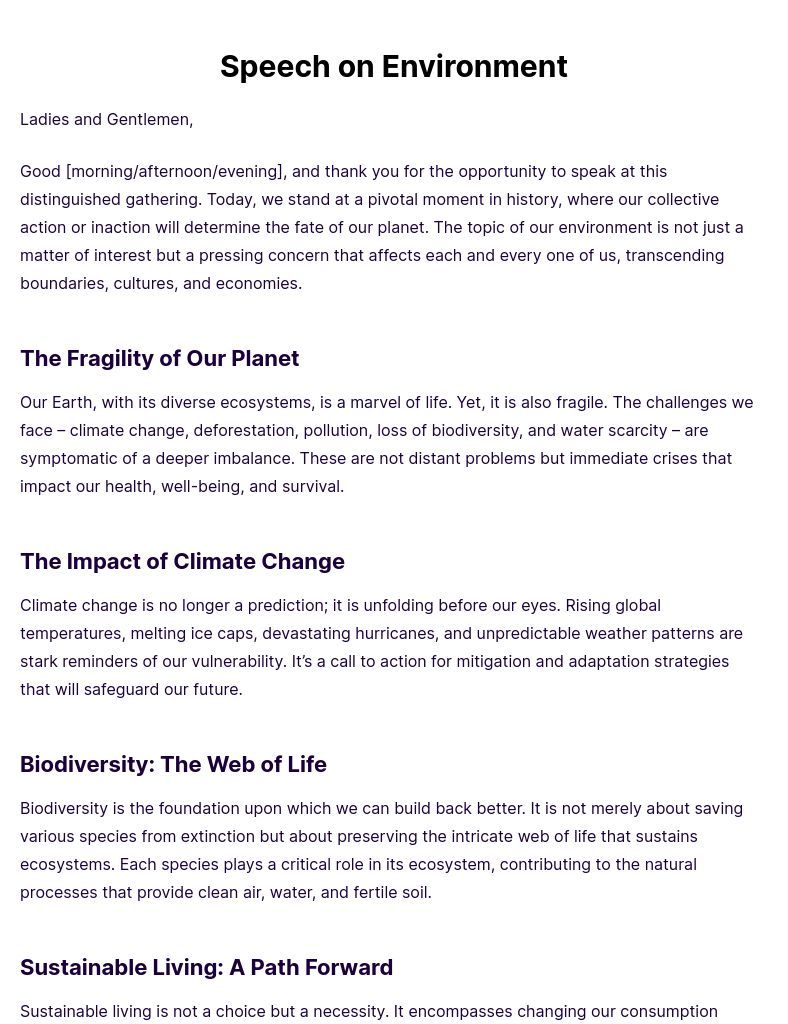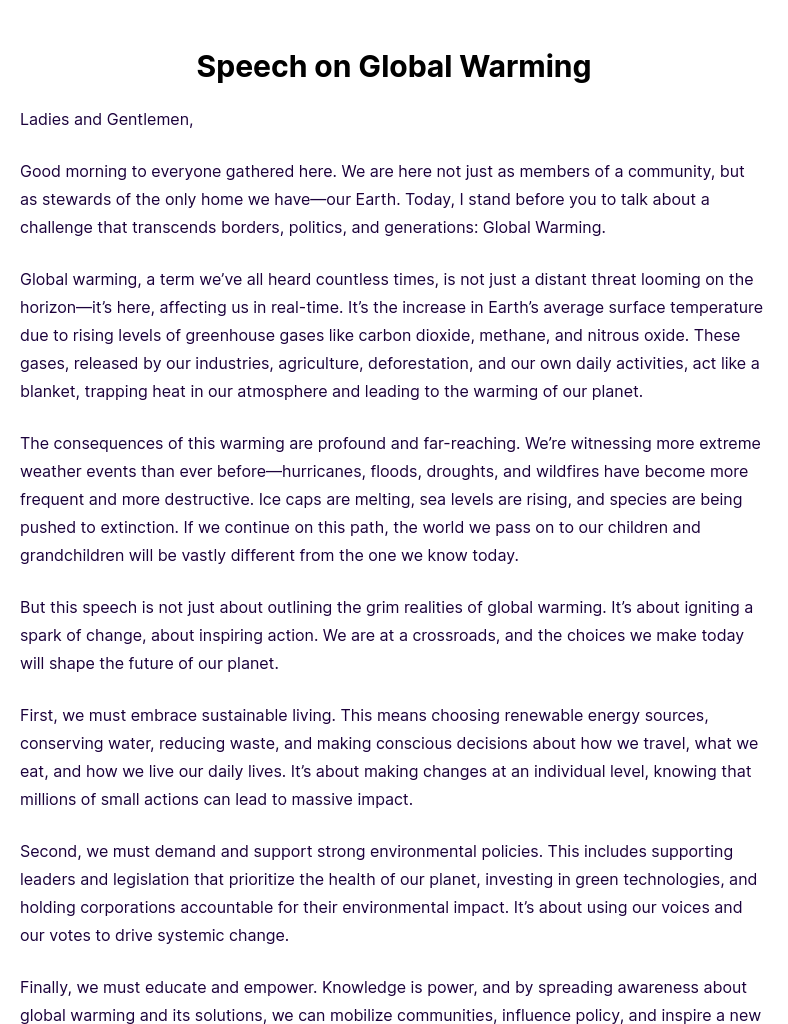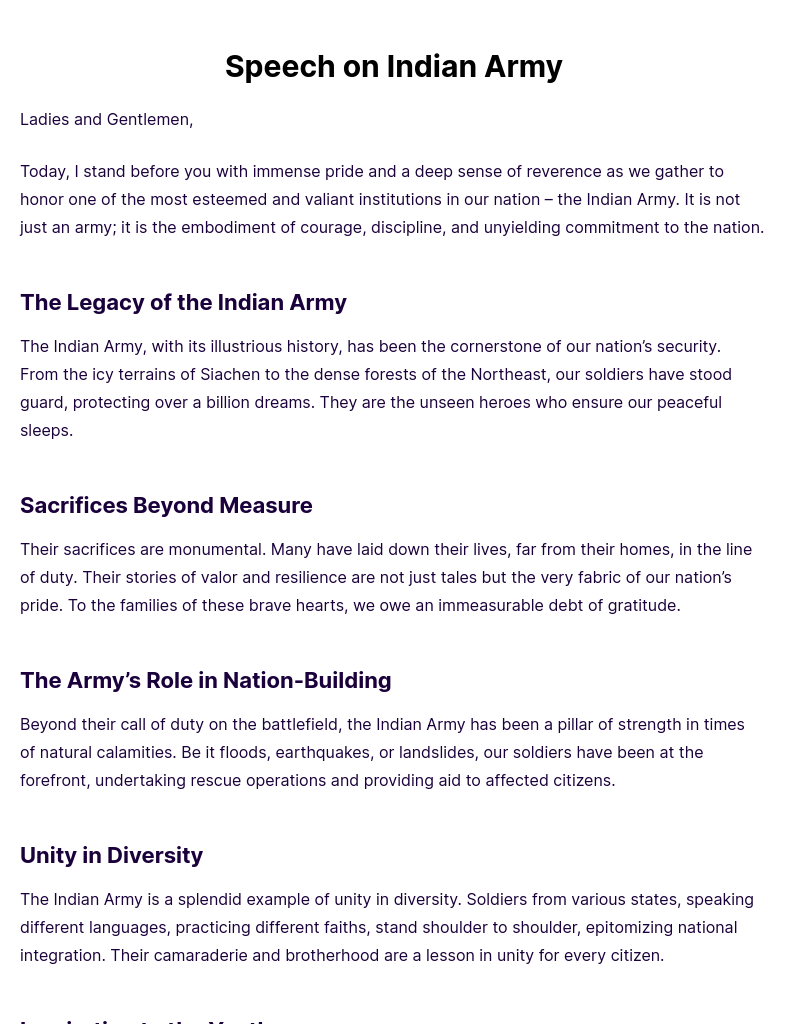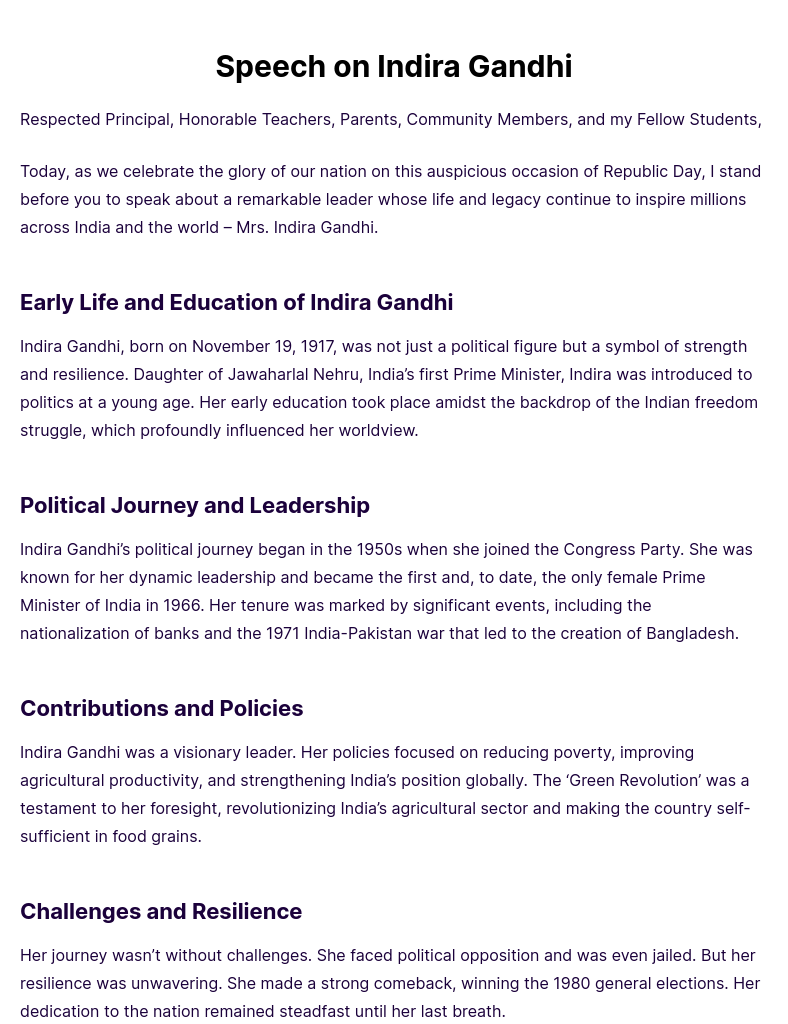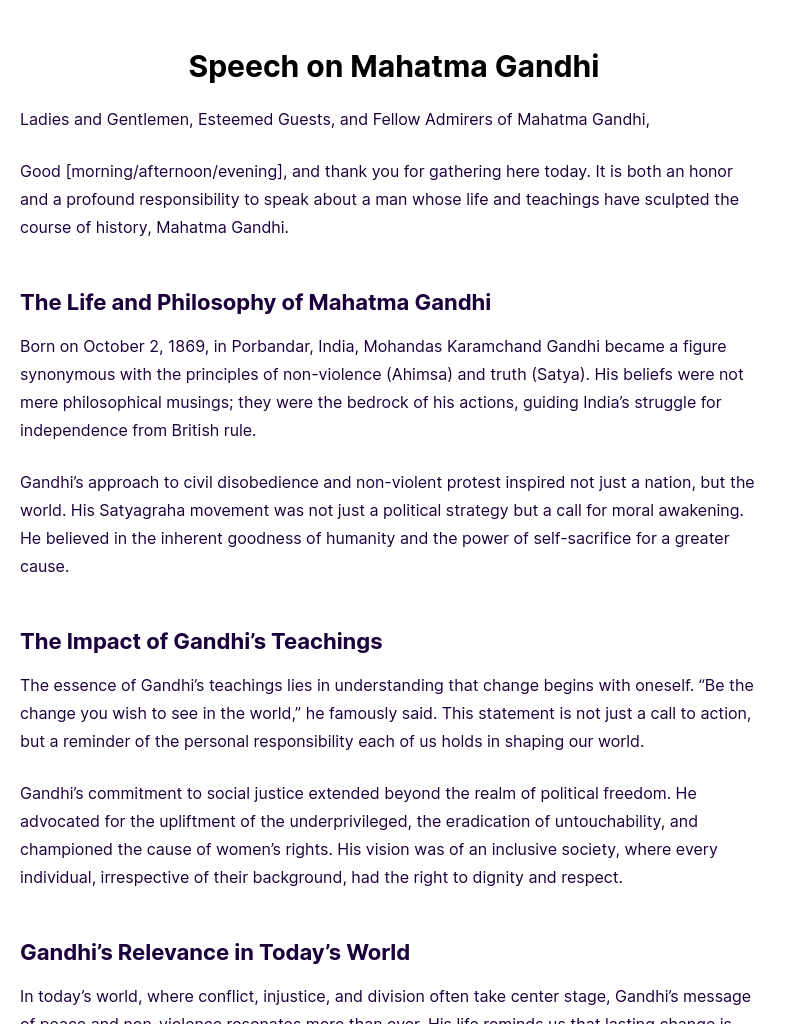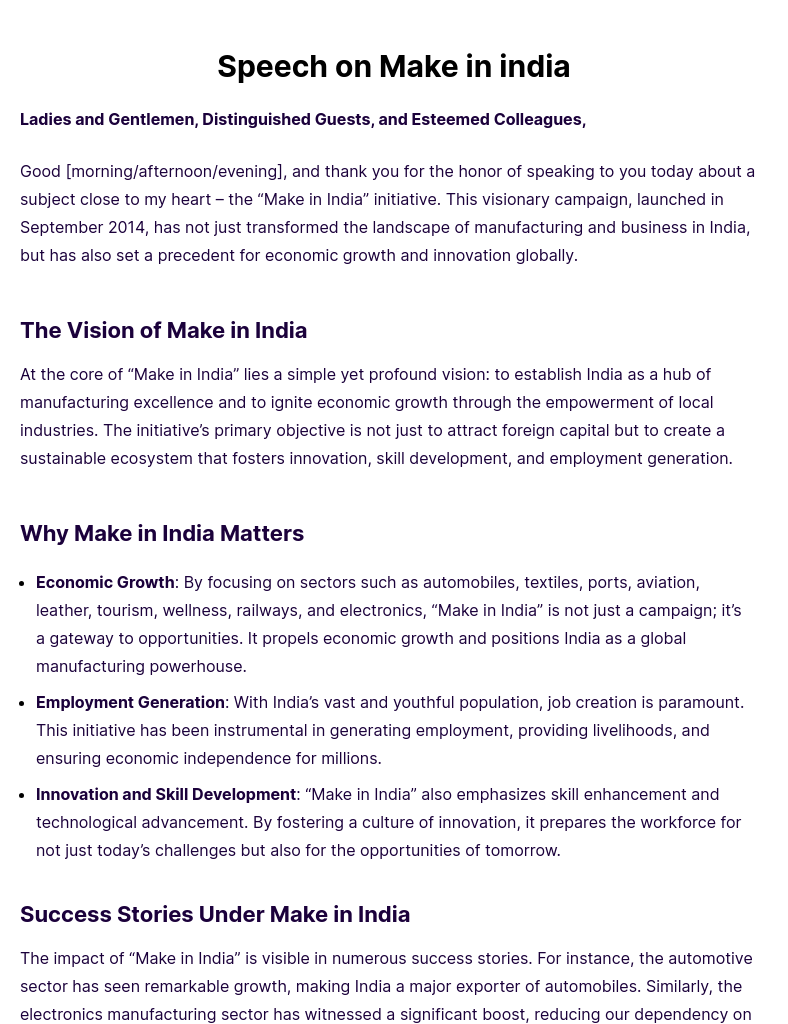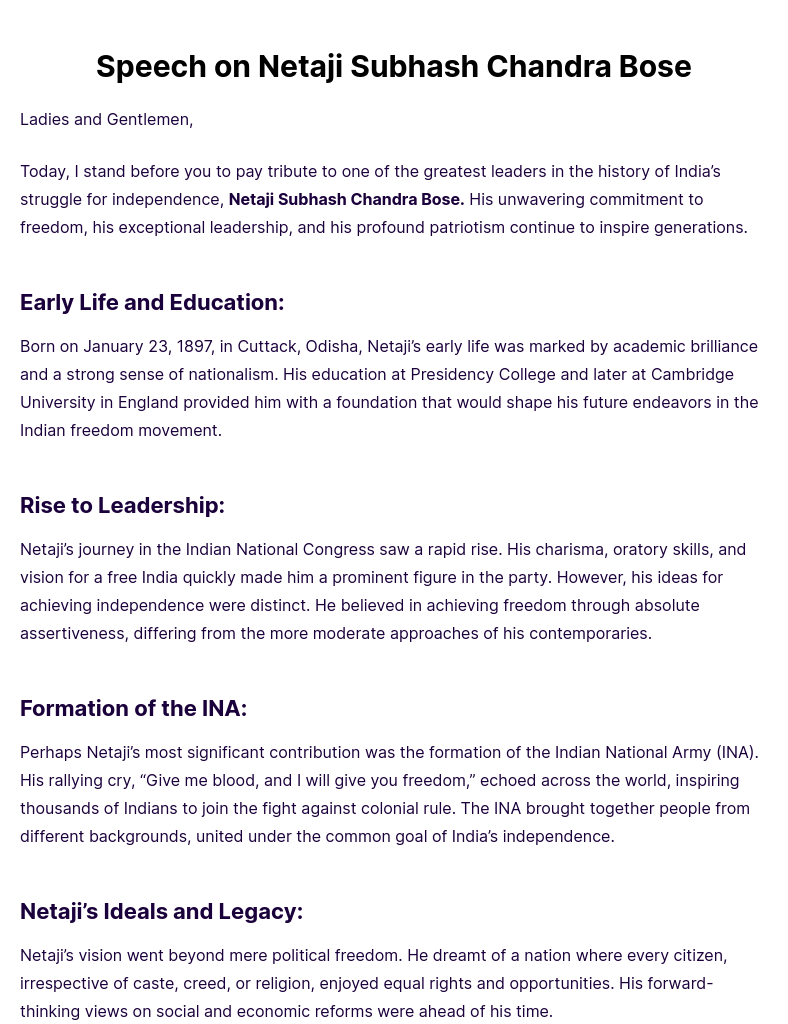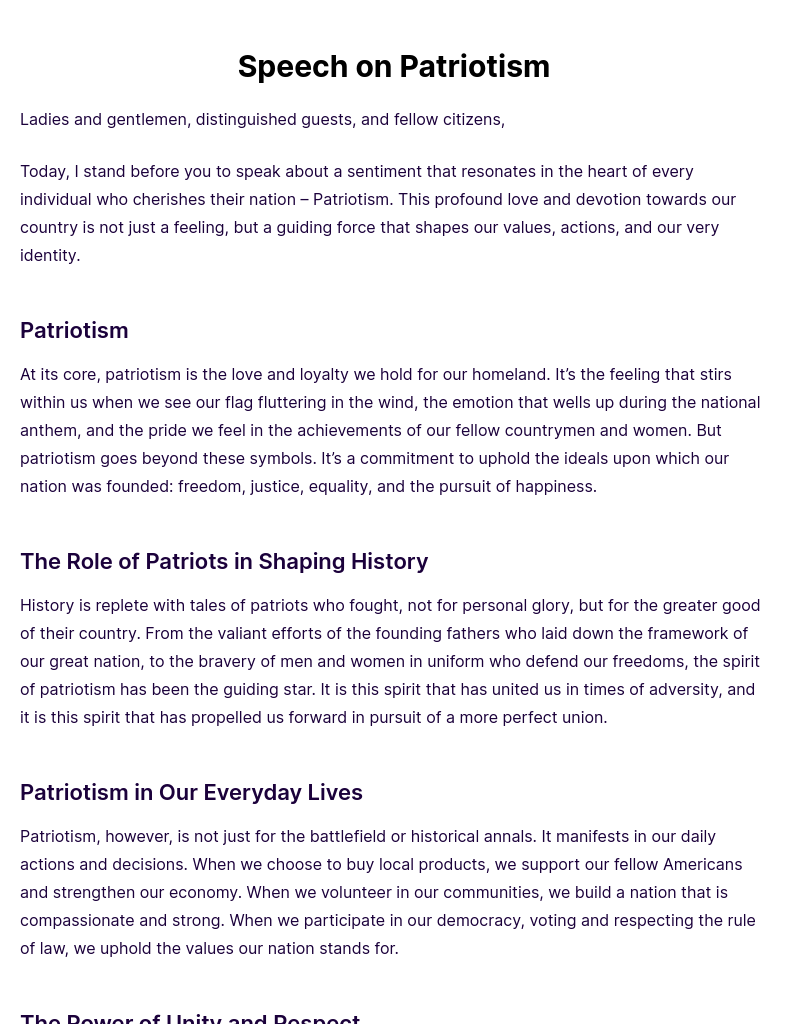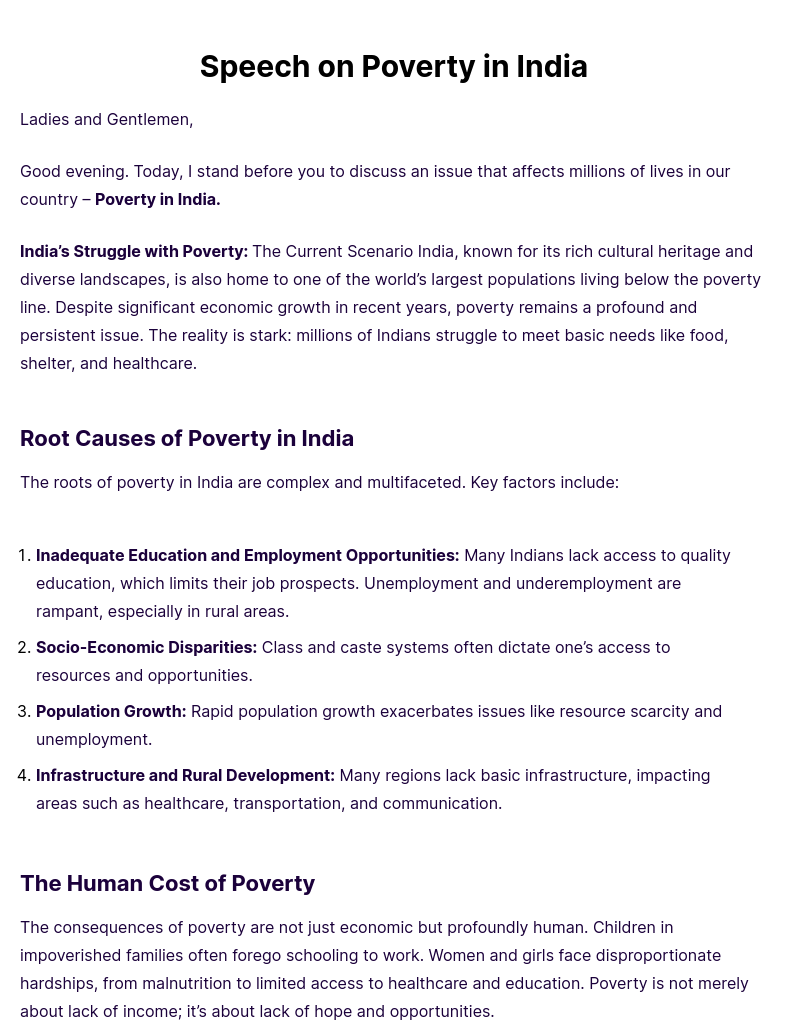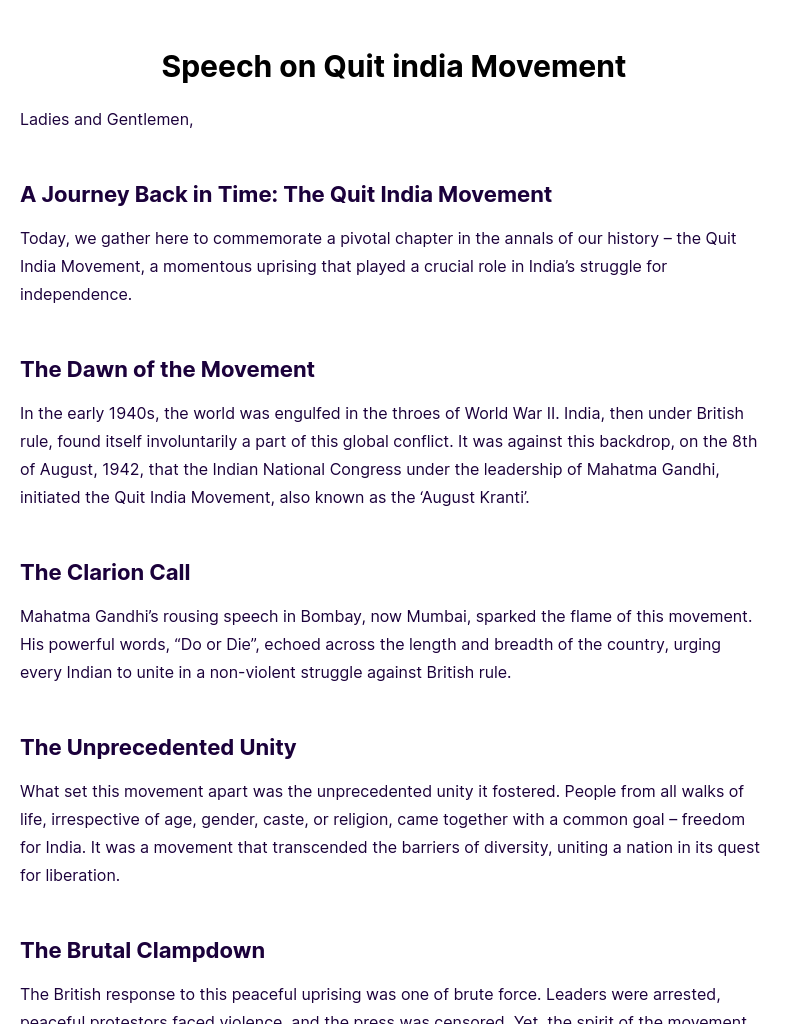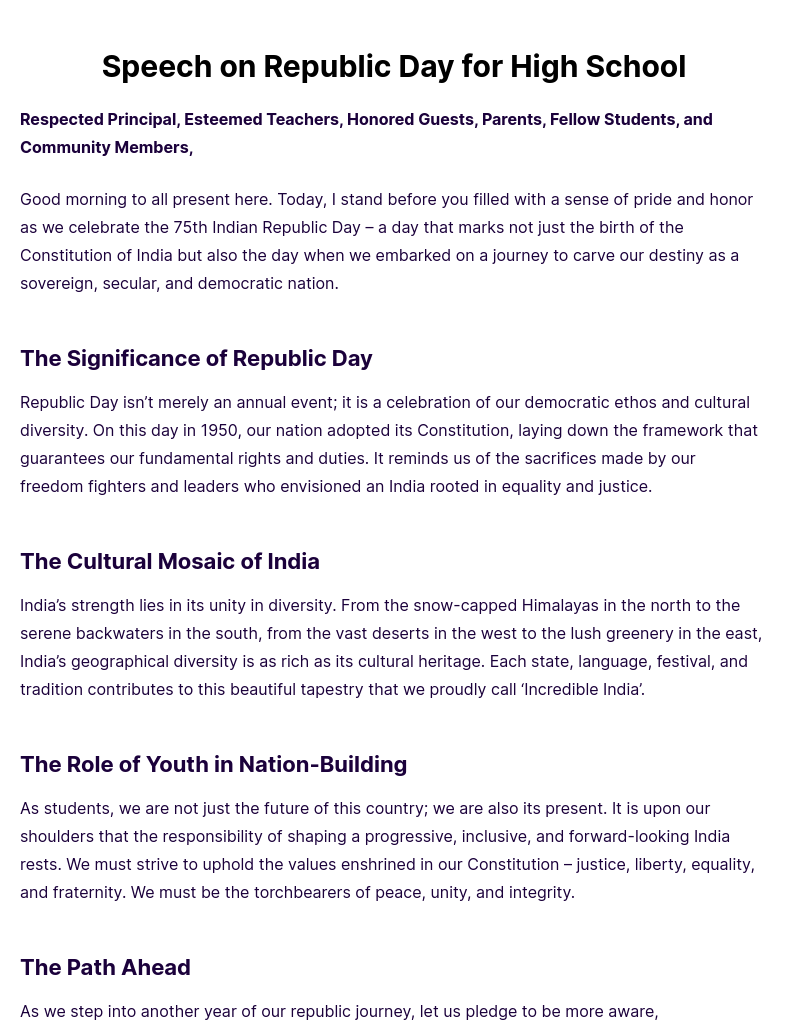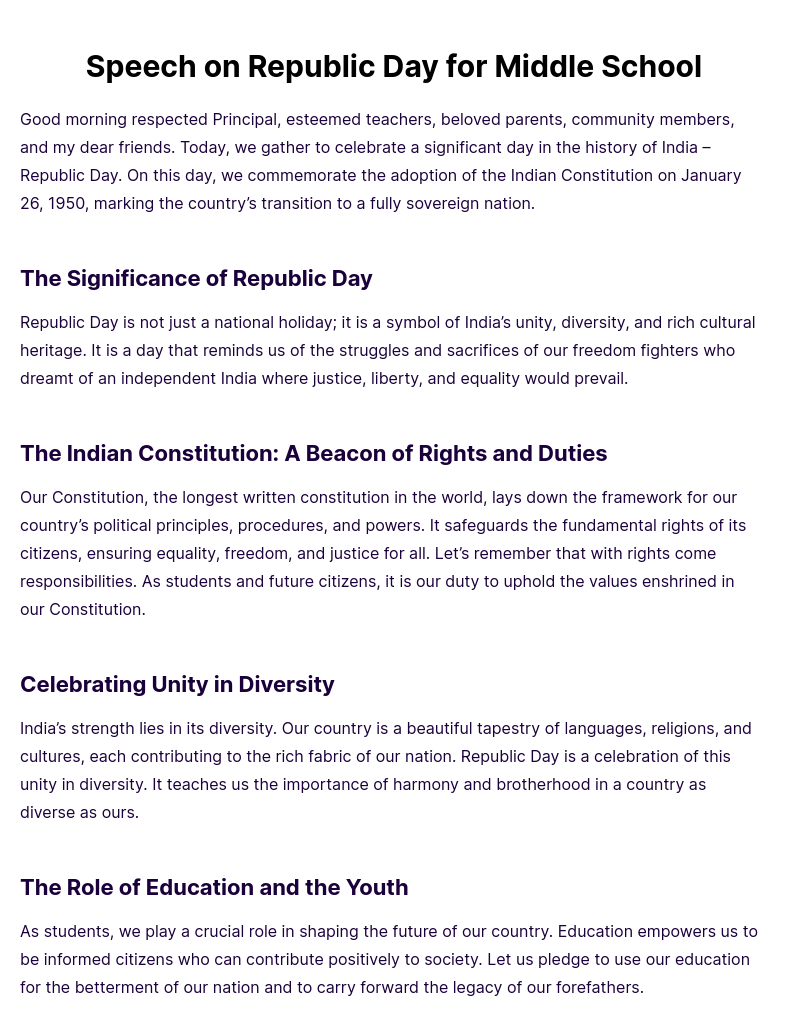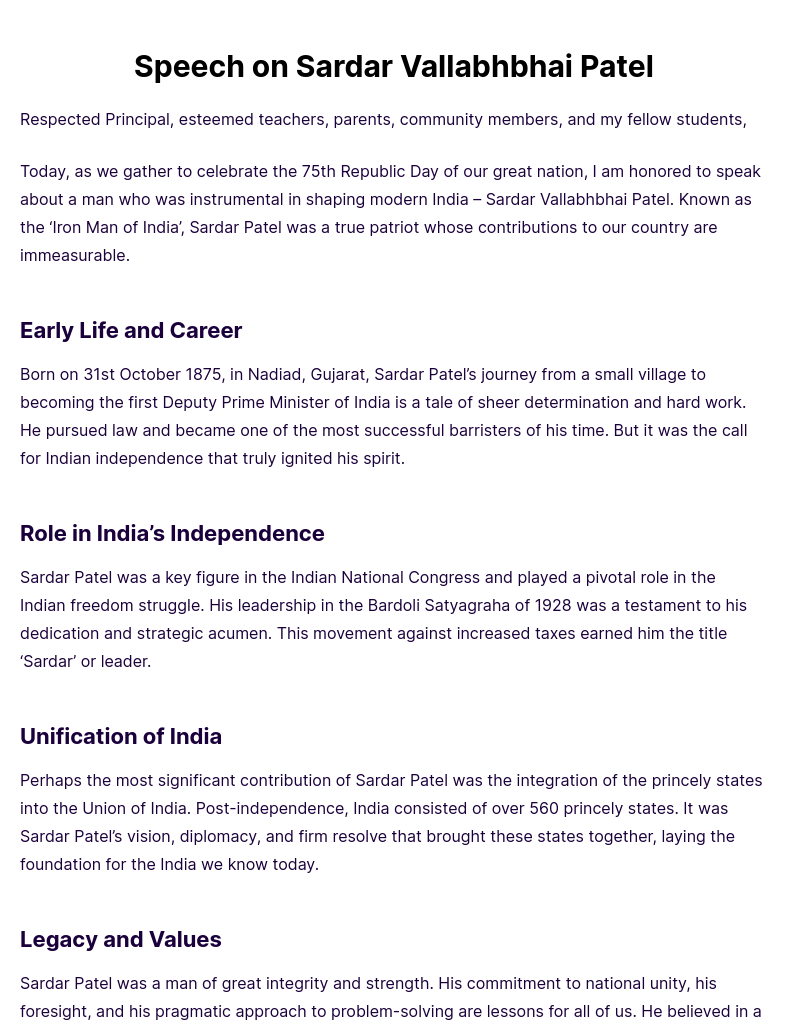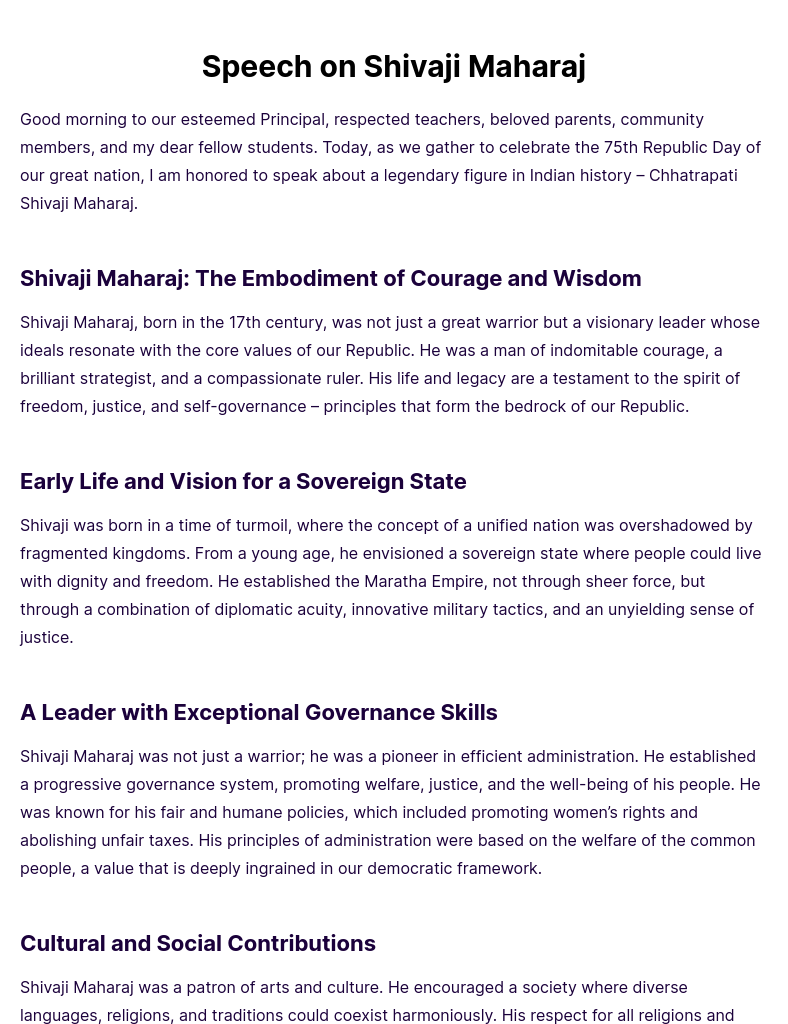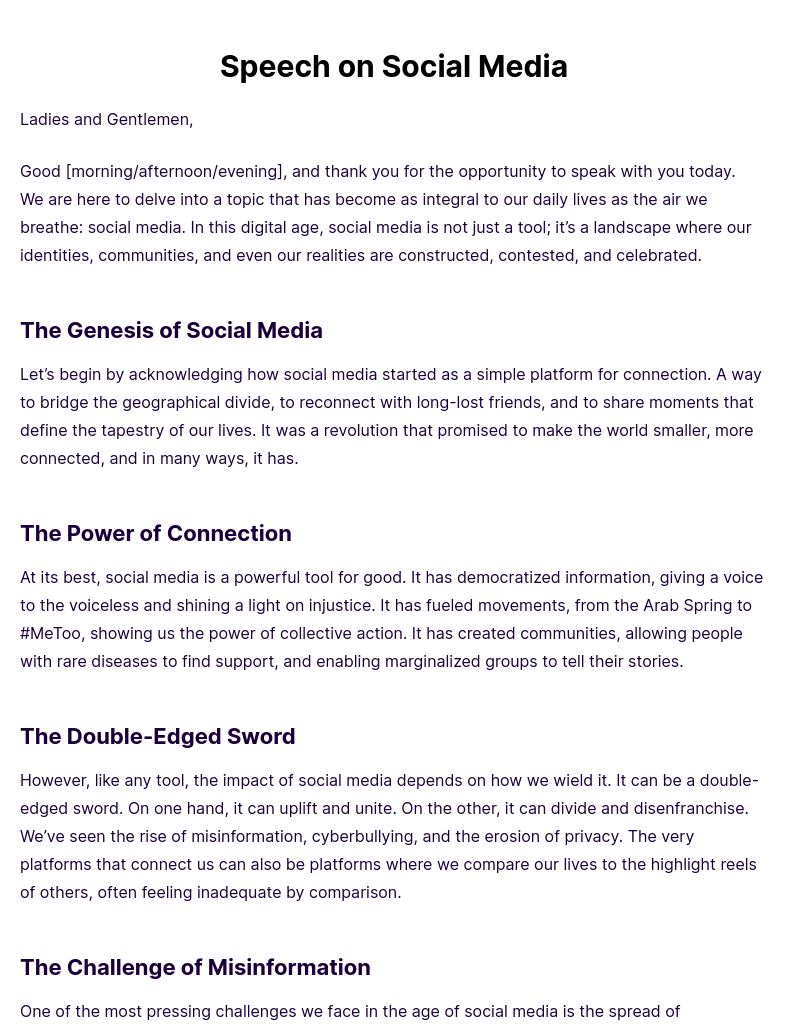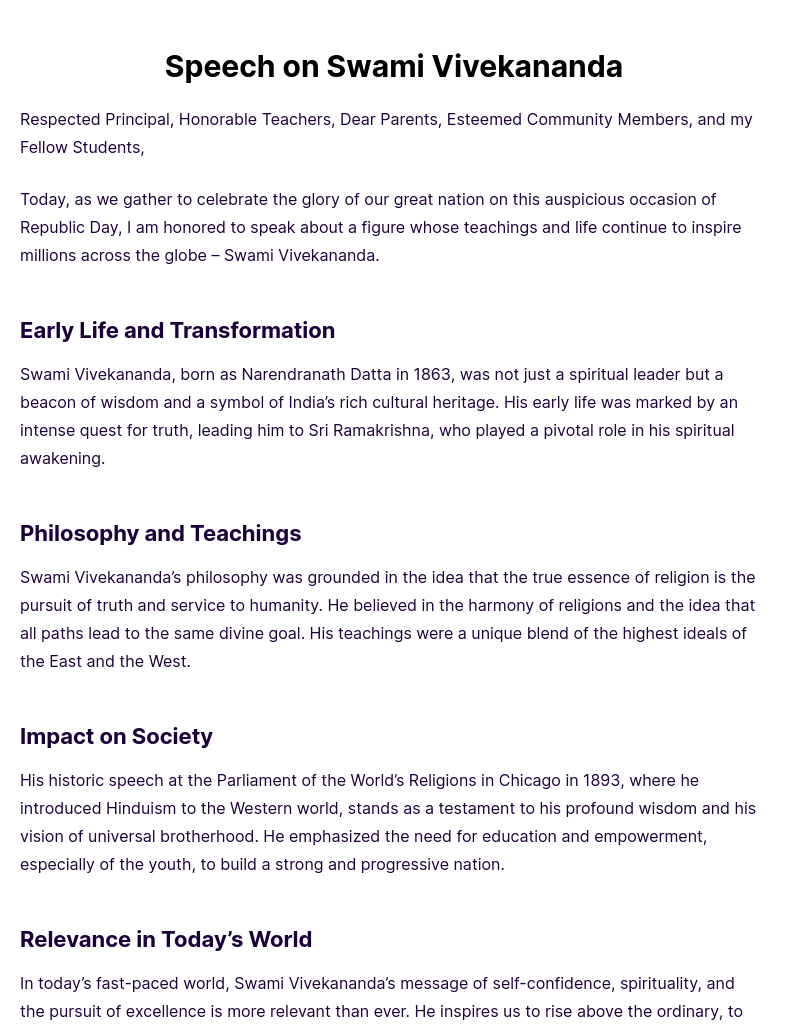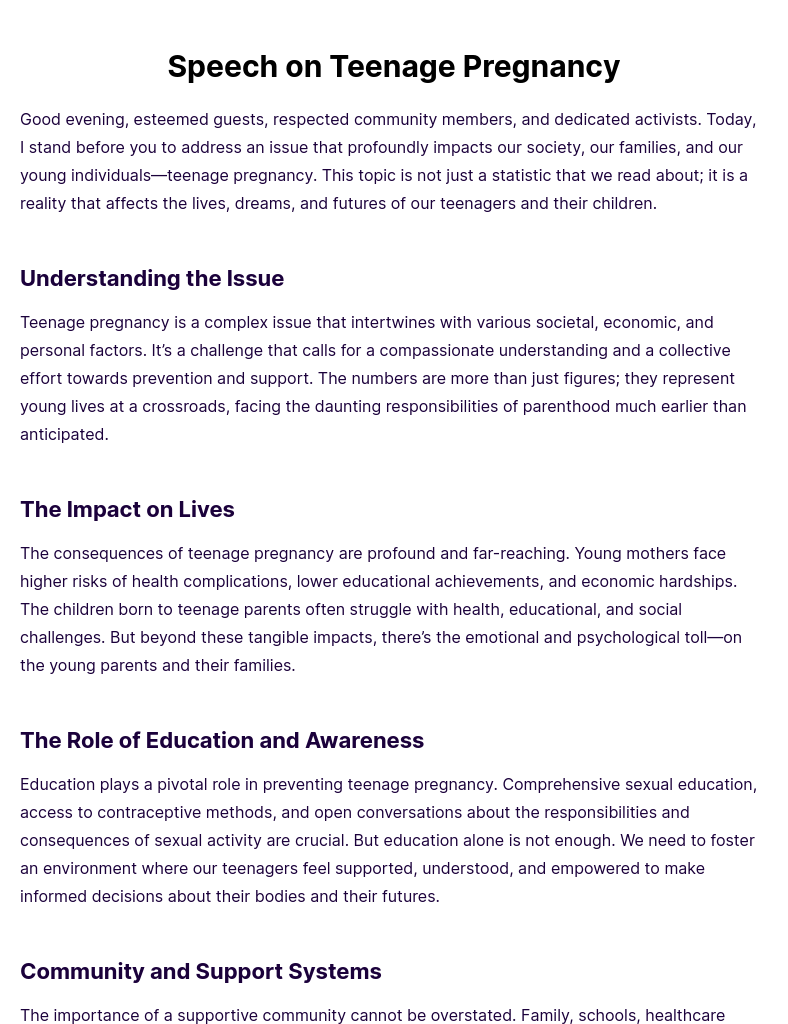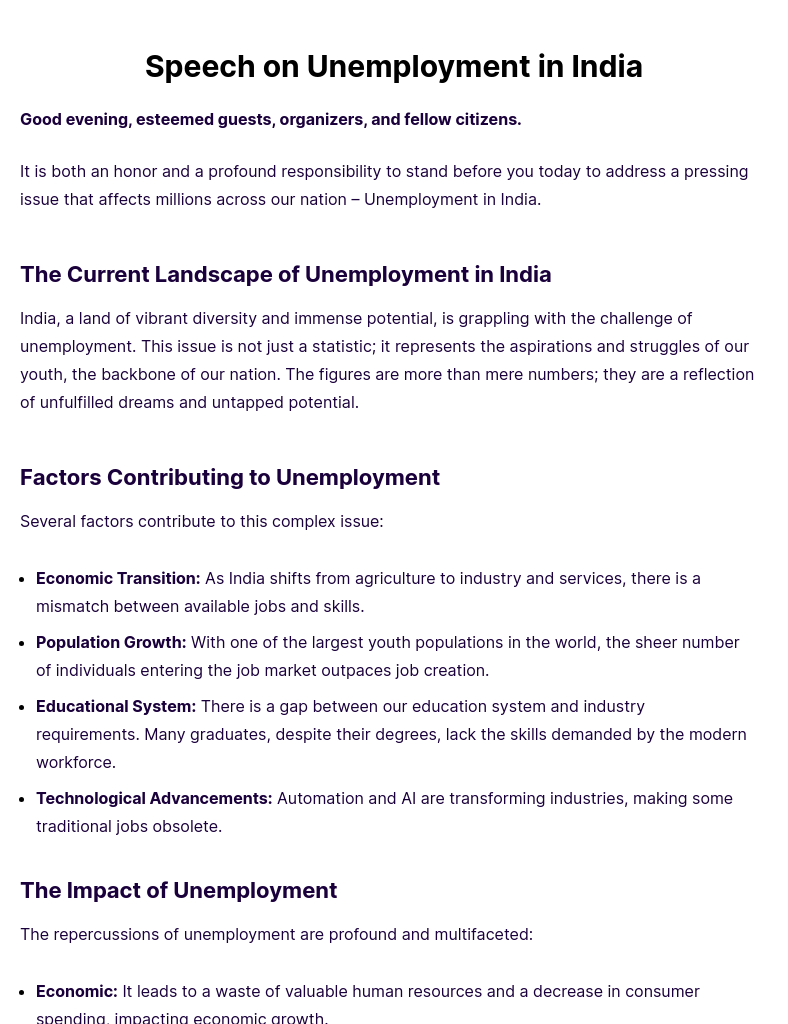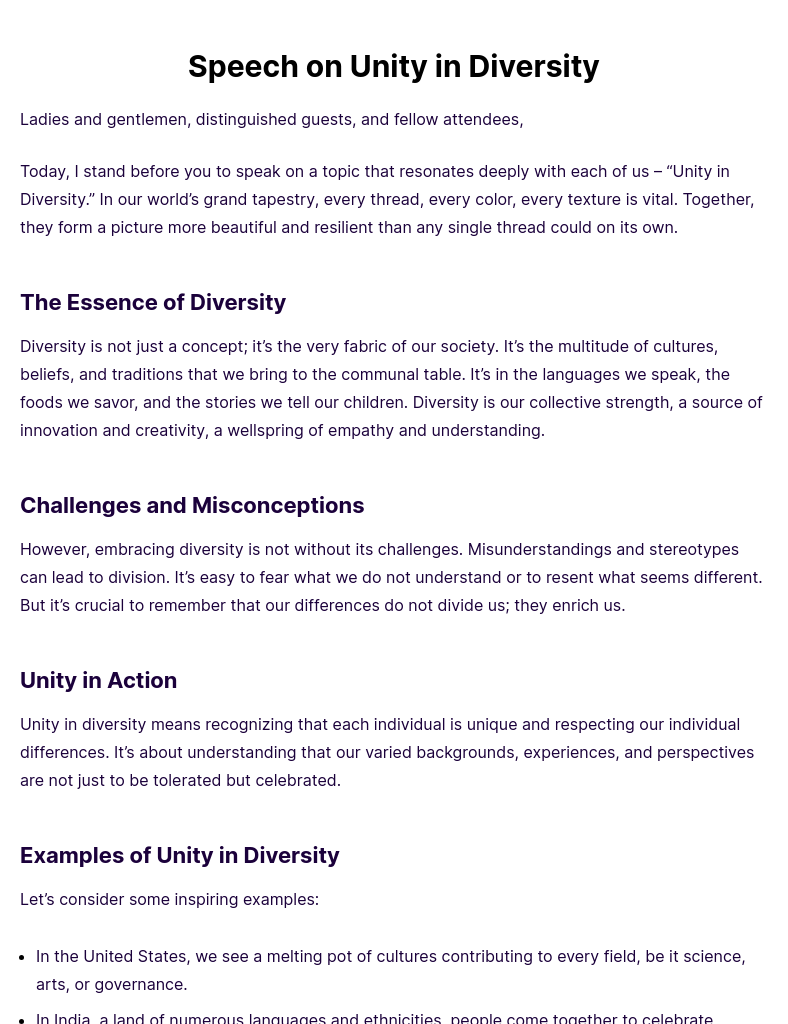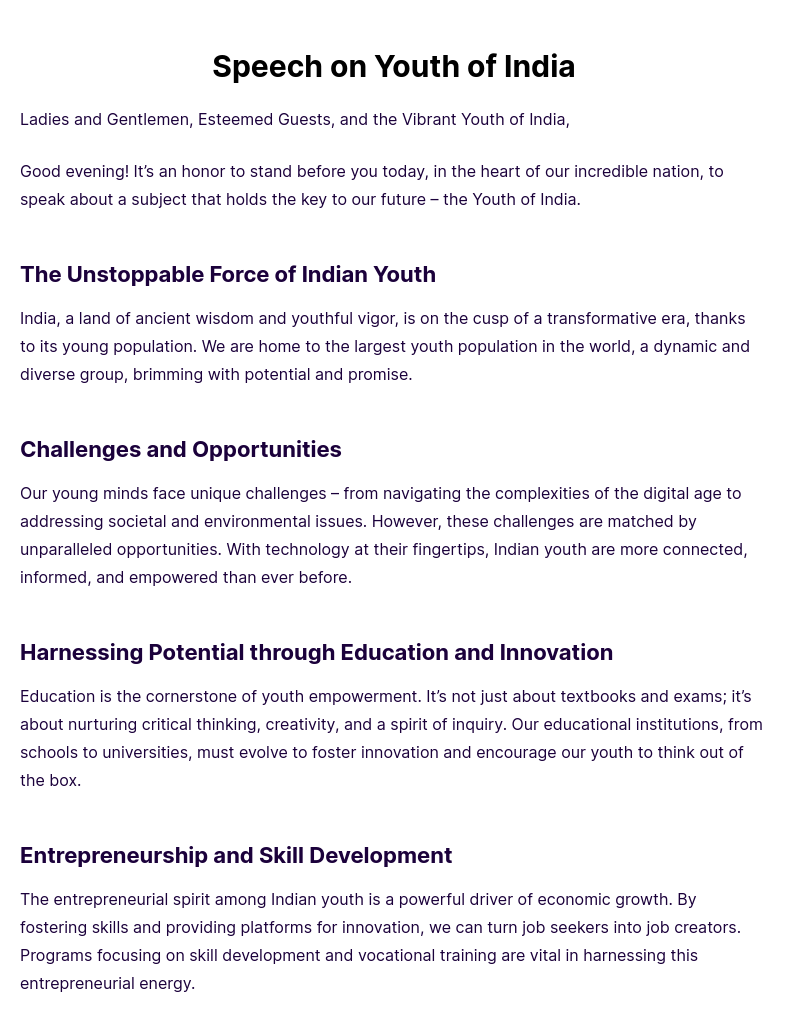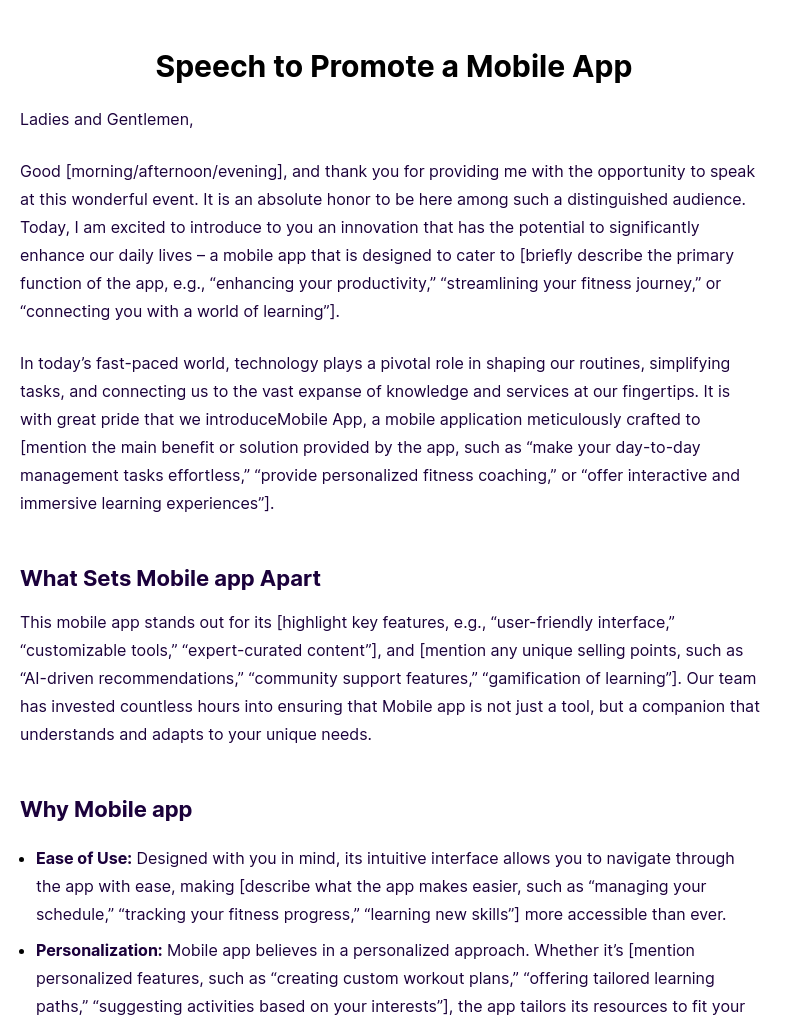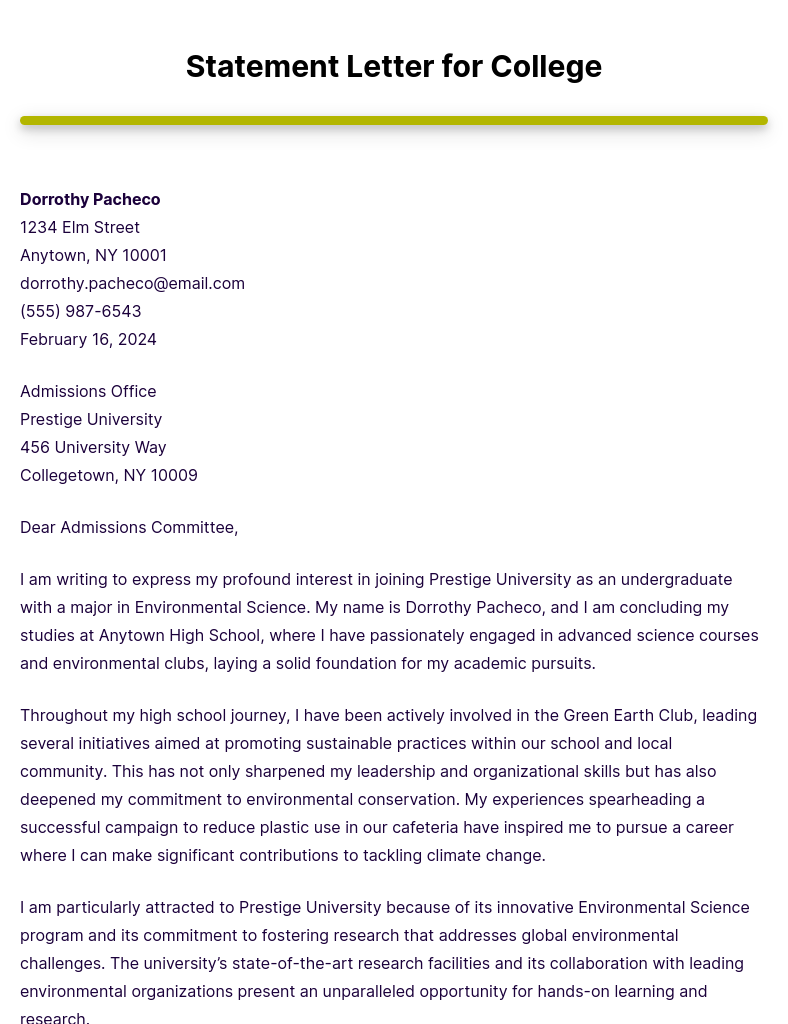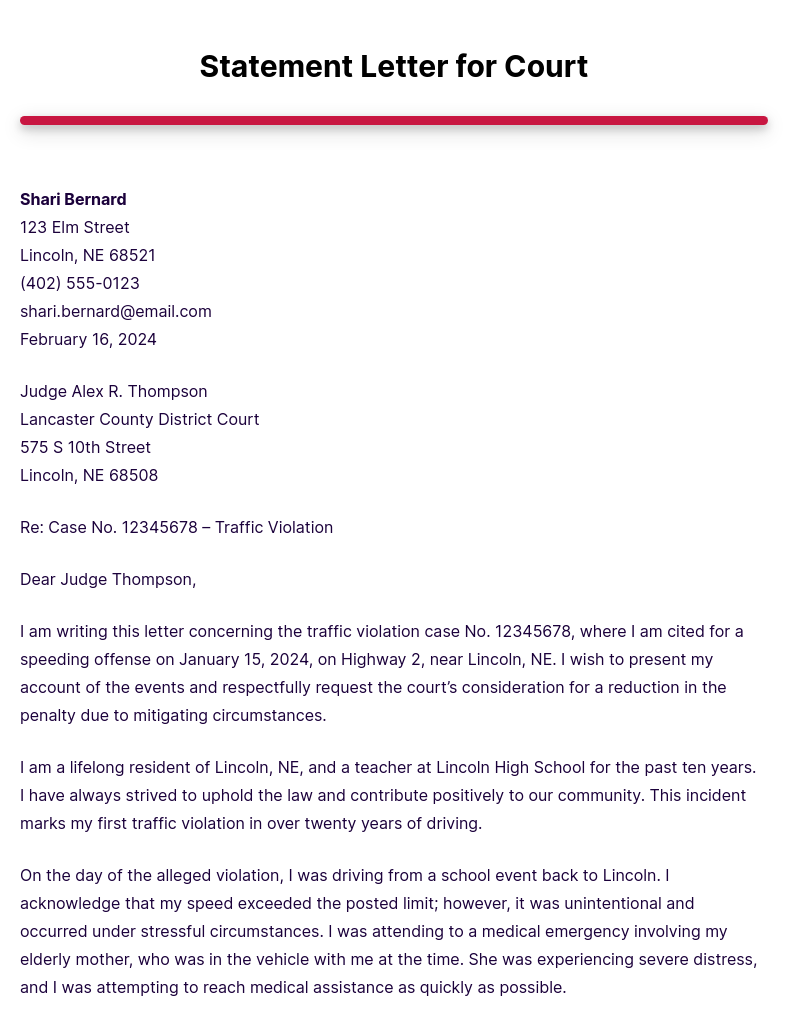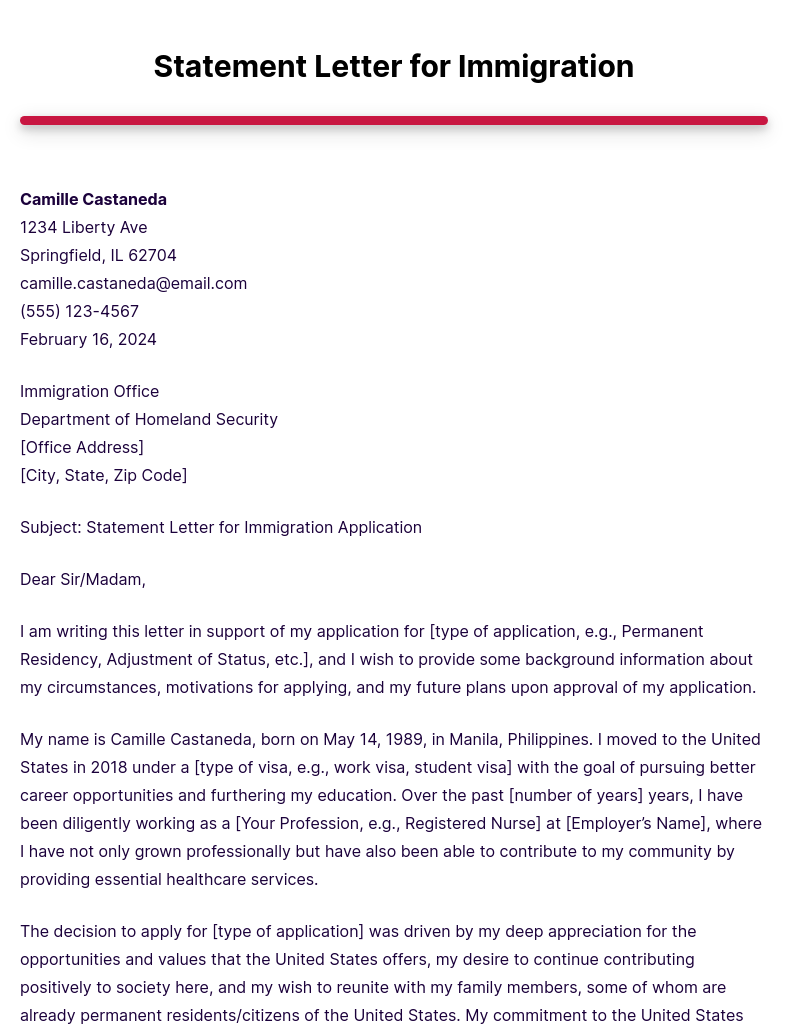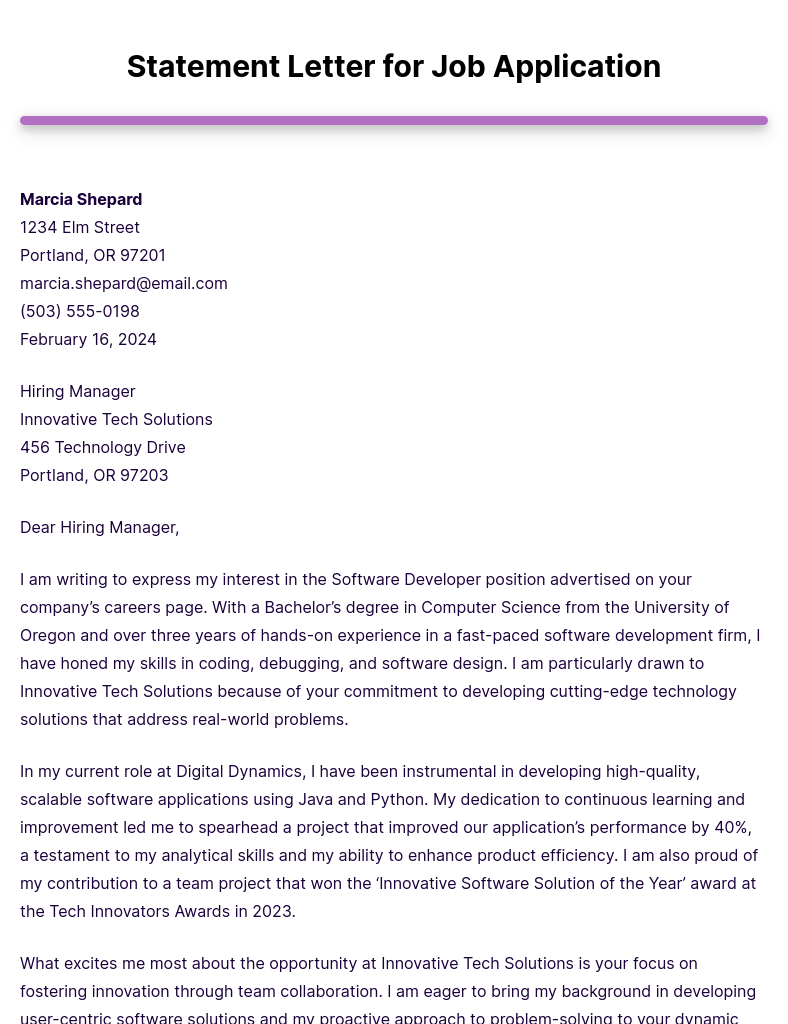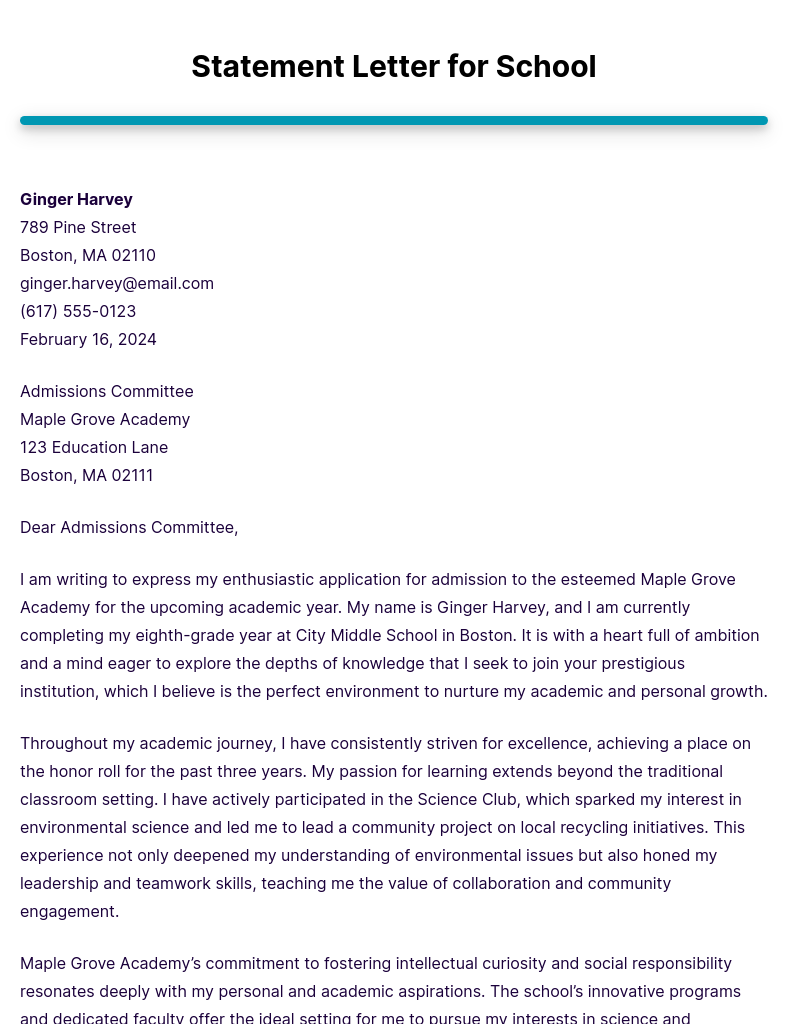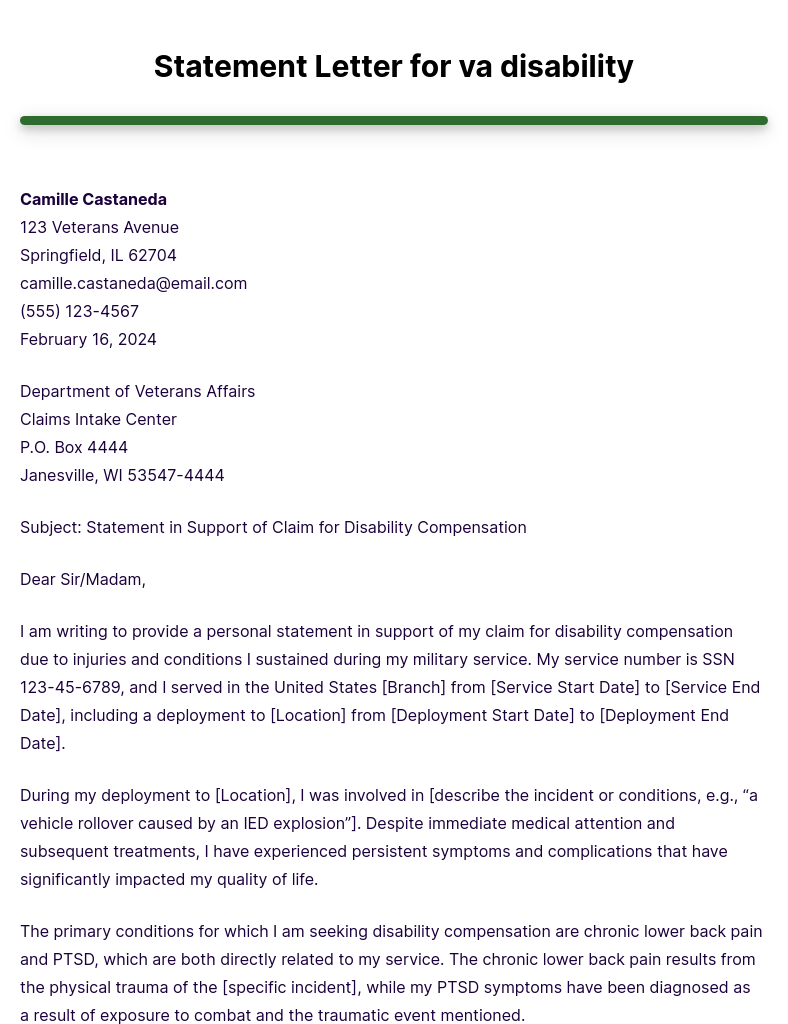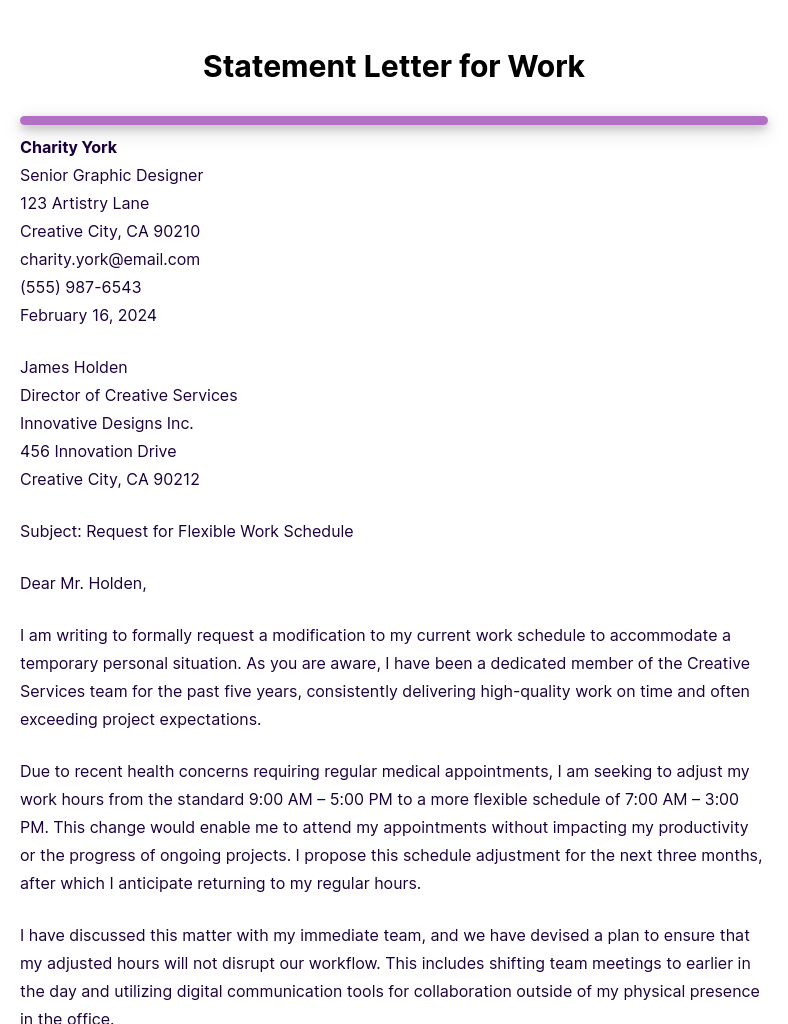Speech, including narrative speech, is a powerful tool for communication, allowing individuals to express thoughts, ideas, and emotions. It encompasses verbal and non-verbal elements, influencing interactions in personal, academic, and professional contexts, shaping opinions and driving social change.
What is Speech?
Speech is the act of expressing thoughts, ideas, and emotions through spoken language. It is a fundamental mode of communication that involves the use of words, tone, Elevator pitch, and body language to convey messages. Speech can be spontaneous or planned, and it varies widely in form and function depending on the context. For instance, casual conversations differ greatly from formal presentations or public addresses. The ability to speak effectively is essential for personal interactions, educational metaphor for success, and professional achievements.
Speech Format
Introduction
Greeting:
- “Good morning/afternoon/evening, everyone.”
- “Hello, ladies and gentlemen.”
Attention Grabber:
- Start with a quote, question, or interesting fact.
Purpose:
- Clearly state the purpose of your speech.
- “Today, I want to talk about…”
Overview:
- Briefly outline the main points you will cover.
Body
Main Point 1:
- Statement: Introduce the first main point.
- Example/Evidence: Provide examples or evidence to support it.
- Explanation: Explain how this point supports your overall message.
Main Point 2:
- Statement: Introduce the second main point.
- Example/Evidence: Provide examples or evidence to support it.
- Explanation: Explain how this point supports your overall message.
Main Point 3:
- Statement: Introduce the third main point.
- Example/Evidence: Provide examples or evidence to support it.
- Explanation: Explain how this point supports your overall message.
50 Speech Examples with Answers
- “Thank you for the award.”: “You’re welcome.”
- “I appreciate your kind words.”: “It’s my pleasure.”
- “Congratulations on your graduation!”: “Thank you very much.”
- “Good morning, everyone.”: “Good morning!”
- “I’m honored to be here.”: “We’re glad to have you.”
- “Happy birthday!”: “Thank you!”
- “Welcome to our event.”: “Thank you for having me.”
- “Let’s work together for a better future.”: “Absolutely, let’s do it.”
- “I’m sorry for the inconvenience.”: “No problem at all.”
- “Please join me in welcoming our guest speaker.”: “Welcome, glad to have you here.”
- “It’s a pleasure to meet you.”: “Likewise, pleasure’s mine.”
- “We can achieve anything if we work hard.”: “Absolutely, hard work pays off.”
- “Thank you for your support.”: “Always happy to help.”
- “I’m grateful for this opportunity.”: “You deserve it.”
- “Let’s make a positive impact.”: “I’m with you on that.”
- “I believe in the power of teamwork.”: “Teamwork makes the dream work.”
- “We must strive for equality.”: “Absolutely, equality for all.”
- “I’m confident in our abilities.”: “That confidence will take us far.”
- “Let’s celebrate our successes.”: “Cheers to that!”
- “Communication is key in any relationship.”: “Couldn’t agree more.”
- “It’s important to listen to others.”: “Listening is learning.”
- “Kindness costs nothing.”: “Indeed, spread kindness.”
- “We should always be open to learning.”: “Learning never stops.”
- “Let’s embrace diversity.”: “Diversity enriches us.”
- “I’m committed to making a difference.”: “Your commitment is admirable.”
- “We need to protect the environment.”: “Earth needs our care.”
- “Education is the foundation of progress.”: “Education empowers.”
- Speech: “Never give up on your dreams.”: “Dreams keep us going.”
- “We must advocate for justice.”: “Justice is everyone’s right.”
- “Let’s support each other.”: “Together we’re stronger.”
- “Hard work pays off.”: “Absolutely, no shortcuts.”
- “Be the change you wish to see in the world.”: “Change starts with us.”
- “I’m proud of our achievements.”: “Proud of you too.”
- “Honesty is the best policy.”: “Absolutely, honesty builds trust.”
- “Let’s foster a culture of innovation.”: “Innovation drives progress.”
- “Every voice deserves to be heard.”: “Your voice matters.”
- “We can overcome any obstacle.”: “Together, nothing can stop us.”
- “Let’s spread kindness and positivity.”: “Kindness is contagious.”
- “Respect is essential in all relationships.”: “Respect builds bridges.”
- “We’re stronger together.”: “Absolutely, unity is strength.”
- “Thank you for your dedication.”: “Dedication is key to success.”
- “Let’s lead by example.”: “Actions speak louder than words.”
- “Gratitude leads to happiness.”: “Grateful for your wisdom.”
- “Let’s build a brighter future for the next generation.”: “The future belongs to them.”
- “I’m inspired by your resilience.”: “Resilience conquers all.”
- “Empathy can change the world.”: “Empathy breeds compassion.”
- “Let’s make the world a better place.”: “One step at a time.”
- “We have the power to create change”: “Change starts with us.”
- “I’m grateful for your friendship”: “Grateful for yours too.”
- “Together, we can achieve anything”: “Absolutely, let’s make it happen.”
Speech Examples for Public Speaking
- “Good morning, everyone.”: “Good morning!”
- “Thank you for inviting me to speak today.”: “It’s an honor to be here.”
- “Let’s take a moment to appreciate the hard work of our team.”: “Absolutely, their dedication is commendable.”
- “I believe that together we can overcome any challenge.”: “Agreed, unity is our strength.”
- “In conclusion, let’s remember that kindness can make a huge difference.”: “Absolutely, kindness matters.”
Speech Examples About Life
- “Life is full of ups and downs.”: “True, it’s a rollercoaster.”
- “We learn from our mistakes.”: “Absolutely, they shape us.”
- “Cherish the moments that matter.”: “Indeed, they’re precious.”
- “Success comes from hard work and perseverance.”: “Agreed, there are no shortcuts.”
- “Embrace change, it’s the only constant in life.”: “Absolutely, adaptability is key.”
Speech Examples for Writing
- “Writing allows us to express our thoughts and feelings.”: “Absolutely, it’s a powerful form of expression.”
- “Every word we write has the potential to impact someone.”: “Indeed, words hold immense power.”
- “Through writing, we can explore new worlds and ideas.”: “True, it’s a journey of creativity.”
- “Practice is key to improving our writing skills.”: “Agreed, consistency leads to growth.”
- “Writing is a lifelong journey of learning and discovery.”: “Absolutely, there’s always more to explore.”
Types of speeches
Informative Speeches: These speeches aim to educate the audience about a specific topic, idea, or concept.
Persuasive Speeches: The goal of persuasive speeches is to influence the audience’s beliefs, attitudes, or behaviors regarding a particular topic or issue.
Special Occasion Speeches: These speeches are delivered during specific events or occasions such as weddings, graduations, or award ceremonies. Examples include wedding toasts, acceptance speeches, or eulogies.
Demonstrative Speeches: Demonstrative speeches involve teaching the audience how to do something or providing instructions, often accompanied by visual aids or demonstrations.
Motivational Speeches: Motivational speeches are intended to inspire and encourage the audience to take action, overcome obstacles, or achieve their goals.
Entertaining Speeches: These speeches focus on entertaining the audience, often through humor, storytelling, or engaging anecdotes.
Impromptu Speeches: Impromptu speeches are delivered without prior preparation and require the speaker to think on their feet and respond quickly to a given topic or prompt.
Debate Speeches: In debates, participants deliver speeches to argue for or against a specific proposition or resolution, presenting arguments and counterarguments to persuade the audience.
Commencement Speeches: Given at graduation ceremonies, commencement speeches often provide advice, reflection, and inspiration to graduating students as they transition to the next phase of their lives.
Keynote Speeches: Keynote speeches are delivered at the beginning or conclusion of an event and set the tone or theme for the gathering. They are often delivered by notable figures or experts in their field.
Differences Between Speech and Language
between speech and language in table format:
| Aspect | Speech | Language |
|---|---|---|
| Definition | The verbal expression of thoughts and ideas through spoken words. | The system of communication using symbols, sounds, or gestures to convey meaning. |
| Form | Involves the physical production of sounds using the vocal apparatus. | Comprises various components such as phonology, morphology, syntax, and semantics. |
| Medium | Typically auditory but can also include non-verbal elements such as gestures and facial expressions. | Can be auditory (spoken language), written (written language), or gestural (sign language). |
| Production | Produced in real-time through articulation and modulation of sounds. | Can be produced in real-time (spoken language), constructed and edited (written language), or conveyed through manual signs (sign language). |
| Comprehension | Requires the ability to perceive and interpret spoken sounds. | Involves understanding the meaning conveyed by spoken, written, or signed symbols. |
| Acquisition | Typically acquired naturally through exposure to spoken language in the environment. | Acquired through exposure, instruction, and interaction with others, starting from infancy. |
| Variability | Can vary in terms of accent, dialect, intonation, and speech rate among individuals. | Can vary across different languages, dialects, and socio-cultural contexts. |
| Disorders | Speech disorders affect the physical production of sounds, such as stuttering or articulation disorders. | Language disorders affect the ability to understand or use language, such as aphasia or specific language impairment. |
| Neurological Basis | Involves the coordination of motor functions in the brain’s speech centers, such as Broca’s area and the motor cortex. | Involves complex neural networks distributed across various regions of the brain, including areas responsible for semantics, syntax, and pragmatics. |
How to start Speech
Begin with a Powerful Quote: Start your speech with a relevant and impactful quote that relates to your topic. This can immediately grab your audience’s attention and create intrigue.
Ask a Thought-Provoking Question: Pose a thought-provoking question that stimulates the audience’s curiosity and encourages them to think about the topic you’ll be discussing.
Tell a Compelling Story: Open with a short anecdote or story that illustrates the importance or relevance of your topic. Stories have a way of drawing in listeners and making your message more relatable.
State a Startling Statistic or Fact: Share a surprising statistic or fact related to your topic. This can grab attention and highlight the significance of what you’re about to discuss.
Use a Personal Anecdote or Experience: Share a personal experience or anecdote that connects you to the topic and helps establish rapport with your audience. Personal stories can make your speech more engaging and relatable.
Create an Atmosphere: Set the scene by painting a vivid picture or describing a scenario related to your topic. Engage the audience’s senses and transport them into the world of your speech.
Start with Humor: A well-timed joke or humorous anecdote can instantly lighten the mood and create a connection with your audience. Just be sure the humor is appropriate for the context and audience.
Make a Bold Statement or Assertion: Begin with a bold statement or assertion that challenges conventional wisdom or provokes thought. This can intrigue your audience and make them eager to hear more.
Acknowledge the Audience: Start by acknowledging the audience and expressing gratitude for their presence. This helps establish a rapport and creates a sense of inclusivity.
Pose a Rhetorical Question: Pose a rhetorical question that gets your audience thinking about the topic and primes them for the message you’re about to deliver.




